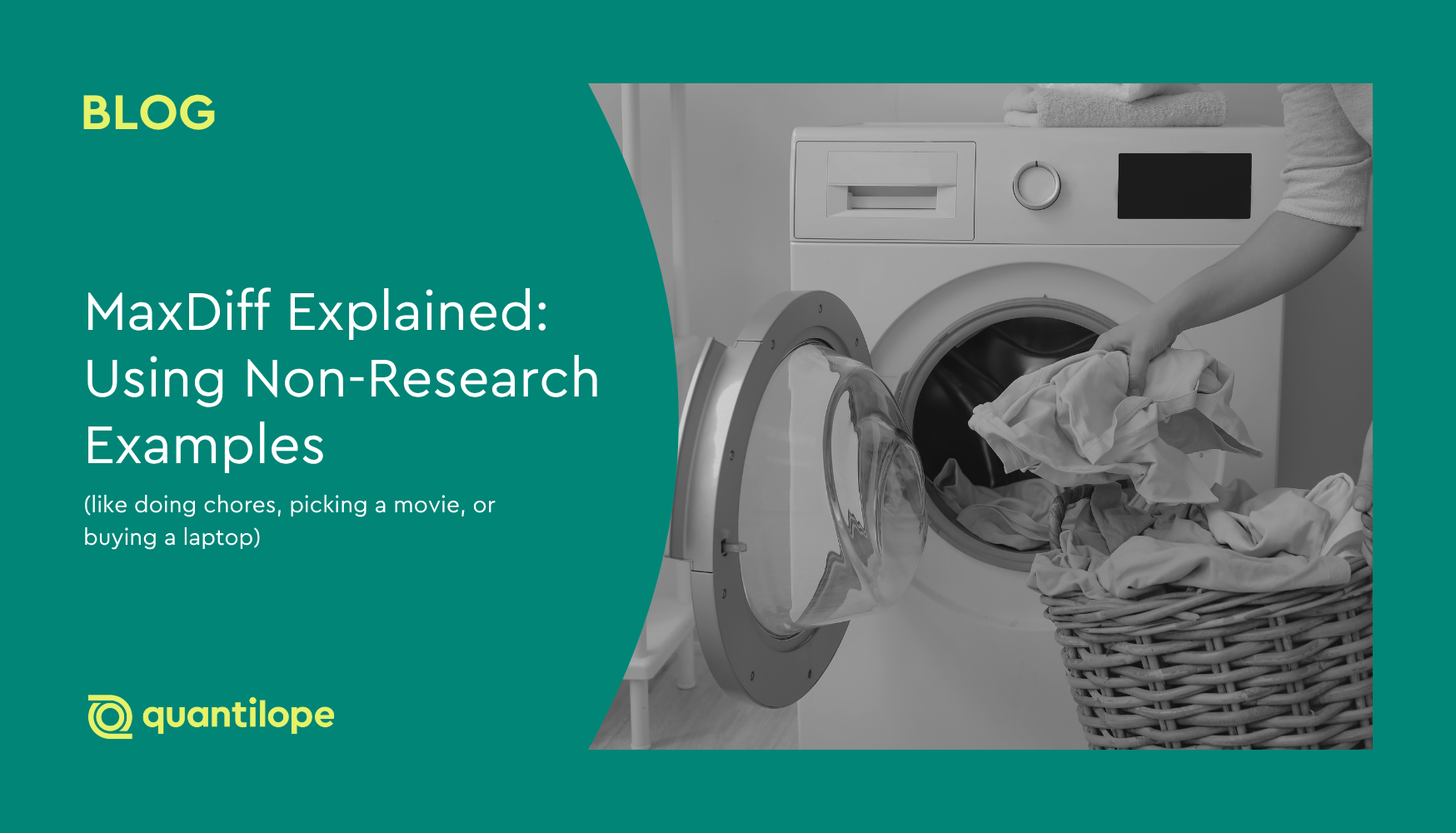This blog provides a clear, digestible overview of one of market research’s most commonly-leveraged methodologies: MaxDiff analysis.
Leveraging a MaxDiff is a great way for brands to narrow their focus and understand what consumers truly consider important. It asks respondents to make a series of forced tradeoff decisions so brands can uncover just how important a specific element or feature is, relative to others - removing the 'everything is important bias' common with multi-select questions.
Table of contents:
What is a MaxDiff and why is it so effective?
MaxDiff is short for Maximum Difference Scaling – also known as Best-Worst Scaling. It’s a powerful market research technique used to determine the relative preference for a list of items, and is one of quantilope’s 15 automated, advanced methods available on the Consumer Intelligence Platform.
Unlike traditional online survey rating scales or multi-select questions where respondents can easily (and sometimes carelessly) rate/consider everything as "very important," a MaxDiff methodology forces respondents to make thoughtful trade-offs by repeatedly choosing what they consider the best and worst options from a rotating subset of items. MaxDiff questions use repetition so that respondents make these tradeoffs among different subsets each time, for a pre-defined number of times.
Breaking it down into "Max" and "Diff":
MaxDiff analysis is about finding the greatest (“Max”) difference (“Diff) in preferences between a set of items. By forcing a best/worst choice within each subset, a MaxDiff reveals which items consumers truly value and which they don't care as much about. We can make these inferences because (within the MaxDiff survey) a respondent might consider one element the ‘best’ from Subset 1, but could end up being their ‘worst’ choice in Subset 2 when presented with different options.
If you’ve ever been to the eye doctor, think of this like the Optometrist flipping between their letter boards and asking which is the ‘clearest’ - 1, 2, or 3. Once you make that choice, they may then compare your chosen version with options 4, and 5 to see if your original choice remains the clearest.
MaxDiff’s proven effectiveness
MaxDiff is a more scientifically rigorous approach to determining consumer preferences compared to traditional rating scales. Rooted in discrete choice analysis, it simulates how consumers make decisions in the real world.
Consider your typical experience when in a store; you don't stand there and rate every single item on the shelf based on specific features. You (usually quickly) pick the one you like most and mentally discard/ignore the one you like least. MaxDiff mirrors this natural behavior by asking respondents to simply choose a 'most preferred' and 'least preferred' option from a set, which is much easier and less taxing than ranking a long list of items.
Not only is this method a more efficient and effective means of research for participants, the resulting MaxDiff data is also far more powerful than other traditional scale/ranking tactics. The MaxDiff results provide a clear, ranked list of preferences from most to least important, giving brands tangible and actionable insights to base decisions on. This eliminates the guesswork of relying on gut feelings or trying to make sense of a list where every item is rated as 'highly important.
Back to Table of Contents
MaxDiff simplified: Non-research examples
To break MaxDiff down even further, below are a few non-research/everyday examples that demonstrate how this methodology works for decision-making.
Scenario: Sunday chores
We’ve all woken up on a Sunday with a seemingly never-ending list of to-dos. However, there’s only so much time in the day, and oftentimes we can’t do it all. Prioritizing chores is a great real-life parallel to how a MaxDiff works, because it demonstrates how we rank long list items by importance (e.g., pay bills, organize the garage, buy groceries, do the dishes, do laundry, vacuum, mow the lawn, dust, meal prep, water the plants).
Instead of rating all of those ten chores on a scale of 1-10 (which might leave you rating six of them as an "8" for importance), we can think of this chore list like a MaxDiff, where we force ourselves to make trade-offs between subsets of those tasks. For instance, you might start by thinking about just four of those 10 tasks at a time (pay bills, vacuum, meal prep, water the plants). From this list, you prioritize the most urgent (pay bills) and de-prioritize the least urgent (vacuum).
Next, you consider a new subset of those chores - say: vacuum, meal prep, do the dishes, buy groceries. In this case, buying groceries is now your biggest priority (especially because you can’t meal prep without buying food first). In this subset, you still consider vacuuming the lowest priority.
Finally, you consider a subset of items that include: vacuum, water the plants, organize the garage, and mow the lawn. Now, vacuuming becomes your top priority - even though you didn’t previously consider it all that important relative to other chores on your to-do list.
By repeatedly choosing the "most" and "least" important tasks across various subsets of chores, you naturally form an idea of priorities. This Sunday, you decide to tackle paying the bills, buying groceries, and vacuuming before anything else. If you have time to get to other tasks, great! If not, you know you accomplished what you consider to be the most important use of your day.
Scenario: Choosing a movie for date night
Now, let’s consider it’s date night and you and your significant other are faced with the seemingly-impossible choice of selecting a movie to watch together. There are dozens of options across a number of streaming services (along with whatever’s available on cable), and you each have different preferences when it comes to content. You can’t sit there and rank all the options available - there’s simply too many to pick from and that would be a poor use of time! You also don’t want to settle on a movie if your significant other says all your suggestions are ‘good with them’. You want to pick something you both genuinely want to watch.
So, you start with three movie titles and you decide on the best option from that set of movies (say, The Dark Knight, Barbie, and The Notebook). You pick The Notebook and your significant other picks The Dark Knight. Now you know you both didn’t want to watch Barbie - and that’s ok!
Next, you choose between The Notebook, The Dark Knight, and The Wizard of Oz. In this case, your significant other still wants to watch The Dark Knight but you’d prefer to watch The Wizard of Oz over The Notebook (even though it was your most preferred when choosing between The Dark Knight and Barbie).
Lastly, you each choose between a final set of movies: The Dark Knight, The Wizard of Oz, and The Great Gatsby. In this case, you both want to watch The Great Gatsby – even though you each previously preferred different options (The Dark Knight and The Wizard of Oz!).
By narrowing down your choices to a subset of all the movies out there, and choosing your most-preferred from each list, you gain clarity into what you actually want to watch, not just what ‘sounds good’. You each get to enjoy a movie you want to see, and you spent hardly any time choosing it.
Scenario: Buying a new laptop
As a final example let’s say you're shopping for a new computer. You’re at the store and you have several options to pick from that you can leave the store with that day. All the laptops have similar but slightly different features: battery life, screen size, processor speed, weight, price, brand reputation, etc.). As you scan the options, you might quickly eliminate ones that are really bulky/heavy. This is what you consider the ‘worst’ feature of laptop computers. Next, you compare the lightweight laptops and find that you care more about a long battery life and fast processing speeds than you do screen size or brand name. As you’re browsing, you’re mentally making these tradeoff decisions which leaves you with two great options:
-
Laptop A: Great battery life, but a slightly slower processor.
-
Laptop B: Fast processor, but average battery life
You ultimately decide you value the faster processor more than the battery life, and end up purchasing Laptop B. You've made a discrete choice based on several rounds of ‘tradeoff’ decisions - whether you realized or not!
___
All three of the example above demonstrate how MaxDiff mirrors our natural cognitive process of making comparative choices. We are much better at identifying the extreme poles of our preferences ("this is a must-have, this is a deal-breaker") than we are at assigning a precise value/importance to every single option in the middle.
Back to Table of Contents
How brands use MaxDiff
Now that you understand how you make MaxDiff-like tradeoff decisions almost every day, let’s explore how brands leverage this powerful survey tool to gain a competitive edge.
MaxDiff is a versatile advanced method, providing clear, actionable insights that can be applied across a wide range of business functions. Below are just a few of the many use cases for a MaxDiff in a research project:
-
Prioritizing concept/product features: Before launching a new product or an updated version of an existing one, companies often use MaxDiff to pinpoint which features deliver the most value. By asking consumers to choose the "most" and "least" desirable features from various sets, a brand can confidently determine if they should invest in a longer battery life, a faster processor, or a larger screen. This ensures they build a product that customers will actually want to buy (similar to our example above in choosing a laptop).
-
Testing marketing & ad messaging: The wrong message can waste millions in advertising spend. MaxDiff helps brands gain valuable insights into which marketing claims, taglines, or advertising concepts resonate most with their target audience. They can test dozens of potential messages and get a clear, ranked list of what’s most compelling, ensuring their campaigns hit the mark every time.
-
Identifying key brand attributes: In a crowded market, knowing what makes your brand unique is crucial. Brands can use MaxDiff to rank brand attributes, helping a company understand which characteristics—such as "innovative," "trustworthy," or "affordable"—are most likely to win over consumers and drive loyalty in their messaging and outreach strategies.
There are so many more advantages of a MaxDiff analysis, helping brands to stop guessing and start making data-driven decisions based on what their customers value the most. While other types of analysis can let you know what’s important, a MaxDiff lets you know just how important.
Back to Table of Contents
Ready to leverage MaxDiff?
quantilope’s automated MaxDiff methodology makes it simple to capture, analyze, and report on consumer preference data. Whether you’re fine tuning product concepts in a new product development cycle, looking to optimize marketing messages for an advertising campaign, or working on a variety of other preference-related initiatives, quantilope’s Consumer Intelligence Platform is your intuitive solution. Our platform uses automation alongside our integrated AI co-pilot, quinn, to make your end-to-end research process quick and simple (even for more complex studies or advanced method projects like a MaxDiff study).
With drag and drop functionality and quinn’s AI-guided assistance, you’ll be able to set up your MaxDiff in seconds. Customize your MaxDiff and any other survey questions however you like, choose your desired panel source (quantilope is panel agnostic), set your study live with the click of a button, and watch as respondents complete your questionnaire in real time. You can also combine MaxDiff with other advanced methodologies in your quantilope study, such as a Conjoint analysis or TURF for even deeper, richer insights.
Get in touch with our team below to start leveraging a MaxDiff analysis for your business needs.



.png)
